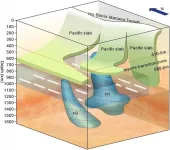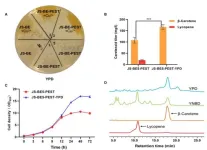(Press-News.org) LAWRENCE, KANSAS — A University of Kansas study of rice paddy snakes in Southeast Asia gives key details to their diversification and natural history, adding molecular evidence that the rise of the Khorat Plateau and subsequent environmental shifts in Thailand may have altered the course of the snakes’ evolution some 2.5 million years ago. The findings were published today in the journal Scientific Reports.
Researchers say the implications could help tell the story of diversification more broadly in the region.
“This paper concerns mud snakes typically found in aquatic systems across Southeast Asia, South Asia, East Asia, Australia and New Guinea,” said lead author Justin Bernstein, a KU Center for Genomics postdoctoral researcher. “Deeper-level relationships regarding their evolution have recently begun to be studied, particularly through genome-scale data. However, finer-scaled evolutionary patterns remain to be fully revealed.”
Bernstein, who currently serves at the University of Texas-Arlington, said the mud snakes, a family known as the Homalopsidae, are commonly found today in aquatic systems. Bernstein’s newest work on the homalopsids focuses on a subgroup called rice paddy snakes that are commonly found in agricultural fields and freshwaters streams in Southeast Asia.
Although recent research has touched on the diversity of rice paddy snakes, their geographic distribution has touched off scientific speculation: One hypothesis suggests that around 2.5 million years ago, a plateau in Central Thailand, known as the Khorat Plateau, emerged from the ground, leading to the separation and subsequent diversification of snake populations over time. Indeed, molecular data provided insights into the timing of species diversification that aligned with the formation of the plateau.
However, a later genome-scale study challenged this hypothesis by pushing the divergence date backward, predating the plateau's formation.
“This discrepancy raises questions about the accuracy of different datasets in determining evolutionary timelines,” Bernstein said. “To address this, our paper employs more limited molecular datasets but with more robust analyses and denser sampling to test the hypothesis. Our results suggest that the group indeed diversified after the Khorat Plateau rose, and environmental changes over time further contributed to their divergence.”
Past that, the research team found varied differences in preferred habitats among different snake species using past and present niche models, hinting that other environmental factors might have influenced their routes toward diversification and geographic distribution.
Bernstein’s collaborator included co-author Rafe Brown, KU professor of ecology & evolutionary biology and curator-in-charge of the Herpetology Division at KU’s Natural History Museum & Biodiversity Institute. Other co-authors included Harold Voris and Sara Ruane of the Field Museum in Chicago; Bryan Stuart of the North Carolina Museum of Natural Sciences; the late Daryl Karns of Hanover College; Jimmy McGuire of the University of California-Berkeley, Djoko Iskandar of the Institut Teknologi Bandung in Indonesia; Awal Riyanto of the National Research and Innovation Agency of Indonesia; Camilo Calderón‐Acevedo of the State University of New York: College of Environmental Science and Forestry; Marcelo Gehara of Rutgers University-Newark; and J. Angel Soto‐Centeno of Rutgers University-Newark and the American Museum of Natural History.
Bernstein and his collaborators relied on molecular data along with ecological niche modeling to shed new light on the rice paddy snakes, which depended on data about where specimens were located in the field. This approach could help conservation efforts going forward, or predictions of how species might fare in climate change scenarios.
“The whole point of ecological niche modeling, put simply, is if I take, say, 100 occurrence points for those snakes, and then I use 19 environmental data layers that correspond with each point, and compare it to a background — which would be the landscape with its environmental data regardless of snake occurrence points — do we see correlations and patterns?” Bernstein said. “You're trying to determine the habitat suitability of your species of interest across a broad landscape, including areas where they have not been recorded from."
He said the environmental data includes variables like temperature differences, seasonality and precipitation at different points in time, such as quarterly, monthly or annually.
"These 19 layers containing the environmental factors are ‘stacked’ in a way that each GPS coordinate — where a snake occurrence record is — has a set of 19 environmental variables associated with it,” Bernstein said.
For instance, via this approach Bernstein said while these rice-paddy snakes don't exist in the Philippines, there are suitable habitats based off of where they live in Indochina.
“Hypothetically they could live there,” he said. “That doesn't mean they do. There is no evidence suggesting they are able to get across ocean waters and enter the Philippines, and it would be highly unlikely for that scenario to occur. But the analysis is just indicating there is suitable habitat elsewhere, in addition to where we find them now, and that can be really useful. If it's a continuous landscape and you haven't found any individuals of a species in a particular area, but you see high habitat suitability, maybe you can go find a population that is presently unknown to exist.”
The research builds on two of Bernstein’s earlier works. One study combines genetic analyses of older museum specimens' mitochondrial DNA with fresher genetic samples from recent field collections of mud snakes to learn more about diversity of homalopsids, including rice paddy snakes. The other study is a more focused study that described a new rice paddy snake species and posited the hypothesis of the Khorat Plateau based on current data but lacked the power to test it.
While many species of the mud snakes are drab, Bernstein said others are highly charismatic.
“Some have tentacles as appendages on their face,” he said. “You could find two of the same species in one hole, like a mud lobster hole, where one is white and black, and the other is bright red and black — very striking. Some have speckled yellow bellies, while others are black with bright orange flecks and stripes down their back. And other species have unique behaviors that are not seen in the 4,000-plus species of snakes. They are truly stunning snakes.”
Ultimately, the mud snake’s value may be in serving to show how species, and their morphological diversity, evolves over time, as well as how other organisms may react to changes in the ecosystems they live in.
“I saw a lot of opportunity in them as a model system for investigating biogeography,” Bernstein said. “Honestly, using them more as a model system for understanding how species change or remain stable over time has been really valuable. We have several studies we want to pursue further, and many more in the works, and it all begins with understanding their evolutionary relationships.”
END
Rice paddy snake diversification was driven by geological and environmental factors in Thailand, molecular data suggests
2024-03-12
ELSE PRESS RELEASES FROM THIS DATE:
Mars attracts: How Earth’s interactions with the red planet drive deep-sea circulation
2024-03-12
Scientists from the Universities of Sydney and Sorbonne University have used the geological record of the deep sea to discover a connection between the orbits of Earth and Mars, past global warming patterns and the speeding up of deep ocean circulation.
They discovered a surprising 2.4-million-year cycle where deep currents wax and wane which, in turn, is linked to periods of increased solar energy and a warmer climate.
The study, published in Nature Communications, tackles the questions of how geological-timescale climate ...
The surprising effect of presence hallucinations on social perception
2024-03-12
If you had to estimate the number of people in a room, without counting them one-by-one, by nature you would overcount them. That’s because, simply put from a Darwinian perspective of how we have evolved, it’s better to overcount potentially harmful agents and predators than to underestimate them. This overcounting social behaviour is shown to be true in humans as well as animals. It’s certainly better to detect too many tigers (even if absent) during a jungle excursion than to miss a hungry one!
Now, EPFL neuroscientists show that if you experience hallucinations, especially ...
Seismological study shows ancient lower mantle flow field under Philippine sea plate
2024-03-12
Researchers from China and Japan have discovered distinct characteristics of the lower mantle flow field. They investigated seismic anisotropy in the upper part of the lower mantle beneath the Philippine Sea Plate (PSP) and found that the ancient lower mantle flow field is still preserved there.
The study was published in Nature Geoscience.
The lower mantle is an important layer of the Earth and may play an important role in the evolution and material cycling of Earth's interior. It is generally believed to be not only the final destination of subducted slabs, ...
Age-related changes in skin may contribute to melanoma metastases
2024-03-12
*EMBARGOED UNTIL TUESDAY, MARCH 12, AT 6 A.M. ET
Age-related changes that cause the skin to stiffen and become less elastic may also contribute to higher rates of metastatic skin cancer in older people, according to research by investigators from the Johns Hopkins Kimmel Cancer Center.
The study, published March 12 in Nature Aging, shows that increased stiffness in aging skin increases the release of a protein called ICAM1. Increased ICAM1 levels stimulate blood vessel growth in the tumor, helping it grow. It also makes the blood vessels “leaky,” enabling tumor cells ...
A coral superhighway in the Indian Ocean
2024-03-12
Despite being scattered across more than a million square kilometres, new research has revealed that remote coral reefs across the Seychelles are closely related. Using genetic analyses and oceanographic modelling, researchers at Oxford University demonstrated for the first time that a network of ocean currents scatter significant numbers of larvae between these distant islands, acting as a ‘coral superhighway.’ These results are published today in Scientific Reports.
Dr April Burt (Department of Biology, University of Oxford, and Seychelles Islands Foundation), lead author of the study, said: ‘This discovery is very important because a key factor ...
Scientists develop a rapid gene-editing screen to find effects of cancer mutations
2024-03-12
CAMBRIDGE, MA -- Tumors can carry mutations in hundreds of different genes, and each of those genes may be mutated in different ways — some mutations simply replace one DNA nucleotide with another, while others insert or delete larger sections of DNA.
Until now, there has been no way to quickly and easily screen each of those mutations in their natural setting to see what role they may play in the development, progression, and treatment response of a tumor. Using a variant of CRISPR genome-editing known as prime editing, MIT researchers have ...
Rainforest's next generation of trees threatened 30 years after logging
2024-03-12
Rainforest seedlings are more likely to survive in natural forests than in places where logging has happened – even if tree restoration projects have taken place, new research shows.
Scientists monitored over 5,000 seedlings for a year and a half in North Borneo.
They studied a landscape containing both natural forest and areas logged 30 years ago – some of which were recovering naturally, while some had been restored by methods including tree planting.
A drought had triggered “mast fruiting” across ...
Expertly engineered saccharomyces cerevisiae yeast strain in the optimized production of carotenoids
2024-03-12
More than 90% of the commercially available carotenoids are synthetically produced using chemicals. To meet the increasing demand for cost-effective natural compounds in carotenoid synthesis, researchers at Xiamen University, China, have developed an engineered S. cerevisiae yeast strain capable of selectively overproducing carotenoids. They redesigned the genomic sequence and critical pathways to optimize carotenoid production. This novel and successful research approach can be extended to other model ...
Beer byproduct behind Marmite could help us recycle metal waste
2024-03-12
When we recycle electronic devices we can no longer use, we expect to make the most out of the precious natural resources that went into building them. But electronic waste is notoriously difficult to recycle, because it’s hard to separate the different metals in the waste from each other. Scientists have now found a way of selectively capturing metals from a waste stream using spent brewer’s yeast, the same beer byproduct that goes into Marmite. Not only that: the yeast can be reused, making the process even more eco-friendly.
“Electronic waste is difficult to recycle because it is very heterogeneous,” said Dr Klemens Kremser ...
Guessing game: Response may bias understanding of future scenarios
2024-03-12
Does previous experience bias a person in future estimations? Yes, Osaka Metropolitan University researchers in Japan report, but only if the person engages higher processing powers by responding, as opposed to simply observing.
They made their findings through experiments involving participants estimating the number of dots flashed on a screen. Participants either had to input their estimate before making another estimate on a new set of dots or were not prompted to do anything but observe. The researchers found ...









